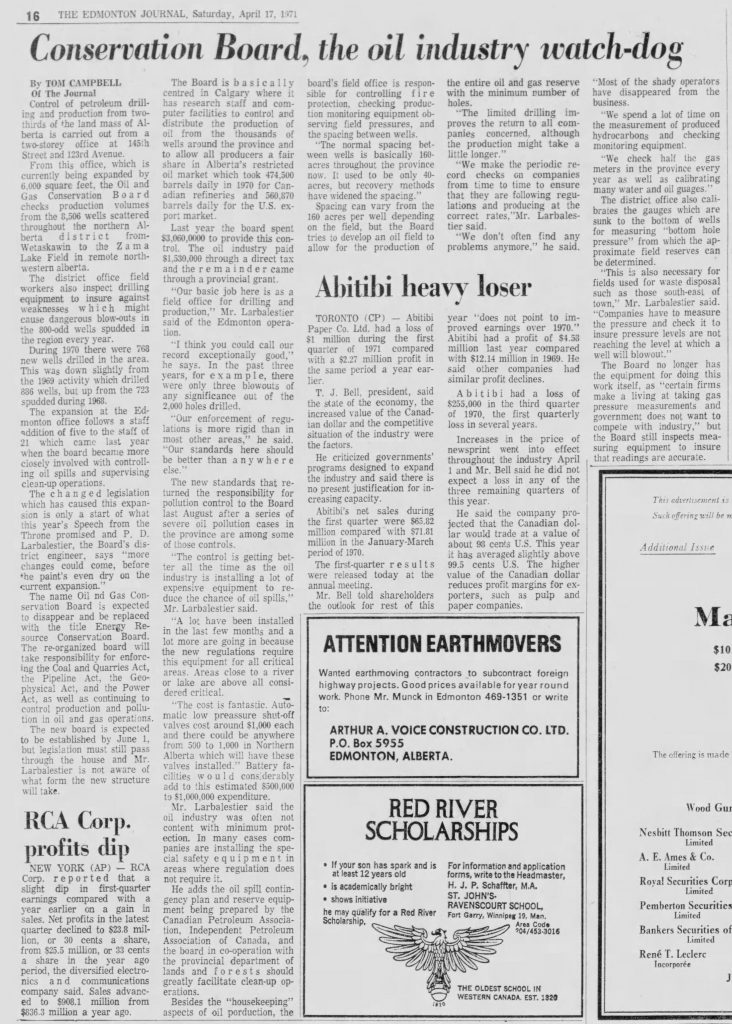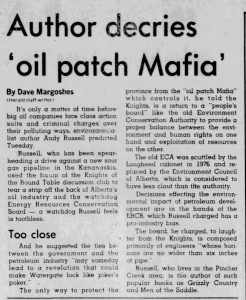
The ERCB then became the EUB after some big pollution problems. Next, after EUB got caught with its deregulatory pants down, lying and spying on innocent citizens, the gov’t turned it unimaginatively back into the ERCB. After Ernst vs Encana/AER/Alberta gov’t lawsuit went public, the gov’t magically turned ERCB into AER, with it’s mandate to operate in the public interest removed.![]()
Conservation Board, the oil industry watch-dog by Tom Campbell, April 17, 1971, The Edmonton Journal (when the journal was still an excellent paper)
… The Board is basically centred in Calgary where it has research staff and computer facilities to control and distribute the production of oil from the thousands of wells around the province and to allow all producers a fair share in Alberta’s restricted oil market which took 475,500 barrels daily in 1970 for Canadian refineries and 560,870 barrels daily for the U.S. export market. …
“Our basic job here is as a field office for drilling and production,” Mr. Larbalestler said of the Edmonton operation.
“I think you could call our record exceptionally good,” he says. In the past three years for example, there were only three blowouts of any significance out of the 2,000 holes drilled.
“Our enforcement of regulations is more rigid than in most other areas,” he said. “Our standards should be better than anywhere else.”
The new standards that returned the responsibility for pollution control to the Board last August after a series of severe oil pollution cases in the province are among some of those controls. …
“The normal spacing between wells is basically 160-acres throughout the province. … Spacing can vary from the 160 acres per well depending on the field, but the Board tries to develop an oil field to allow for the production of the entire oil and gas reserve with the minimum number of holes. “The limited drilling improves the return to all companies concerned, although the production might take a little longer.”

“The normal spacing between wells is basically 160-acres throughout the province. … Spacing can vary from the 160 acres per well depending on the field, but the Board tries to develop an oil field to allow for the production of the entire oil and gas reserve with the minimum number of holes.
“The limited drilling improves the return to all companies concerned, although the production might take a little longer.”

Fast forward to the frac’ing gang rape of Alberta that escalated in earnest in 2001, led notably by condom-less illegal aquifer frac’er Encana/Ovintiv:


The black dots are deeper wells, many by Encana.
Each section (numbered in the centre) is 320 acres and 1 mile square, and would only have 2 wells per section based on the rules in 1971. Many more wells were drilled and frac’d after the above map was created, including in the fresh water zones.
Slides above from Ernst presentations.

“We make the periodic record checks on companies from time to time to ensure that they are following regulations and producing at the correct rates,” Mr. Larbalestier said. ![]() And, most importantly, warn companies ahead of regulator “checks” to make sure they find nothing wrong?
And, most importantly, warn companies ahead of regulator “checks” to make sure they find nothing wrong?![]()
“We don’t often find any problems anymore,” he said. ![]() That’s cause they don’t look! And even if they look and find problems, the gov’t just changes the regulator’s spots – again and again and again, to distract from those problems.
That’s cause they don’t look! And even if they look and find problems, the gov’t just changes the regulator’s spots – again and again and again, to distract from those problems.![]()
“Most of the shady operators have disappeared from the business.” ![]() No they didn’t! The regulator (of many-changing-spots) welcomes shady operators and helps them spread like a coronavirus. Refer to the thousands of posts on this website and below for a tiny sampling!
No they didn’t! The regulator (of many-changing-spots) welcomes shady operators and helps them spread like a coronavirus. Refer to the thousands of posts on this website and below for a tiny sampling!![]()
Author decries ‘oil patch Mafia’ by Dave Margoshes, July 17, 1981
It’s only a matter of time before big oil companies face class action suits and criminal charges over their polluting ways, environmentalist author Andy Russell predicted….
Russell…used the forum of the Knights of the Round Table discussion club to tear a strip off the back of Alberta’s oil industry and the watchdog Energy Resources Conservation Board – a watchdog Russell feels is toothless.
Too Close
And he suggested the ties between the government and the petroleum industry “may someday lead to a revelation that could make Watergate lok like piker’s poker.”

The only way to protect the province from the “oil patch Mafia” which controls it, he told the Knights, is a return to a “people’s board” like the old Environment Conservation Authority to provide a proper balance between the environment and human rights on one hand, and exploitation of resources on the other. …
Decisions affecting the environmental impact of petroleum development are in the hands of the ERCB, which Russell charged has a pro-industry bias. ![]() Like our courts.
Like our courts.![]()
The board, he charged, to laughter from the Knights, is composed primarily of engineers “whose horizons are no wider than six inches of pipe.” …
